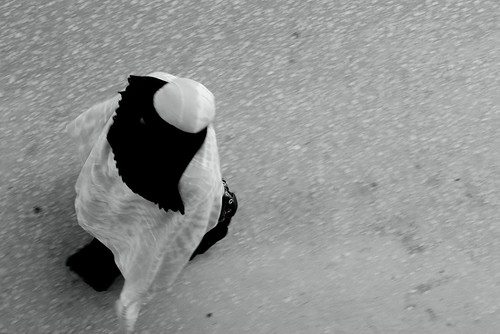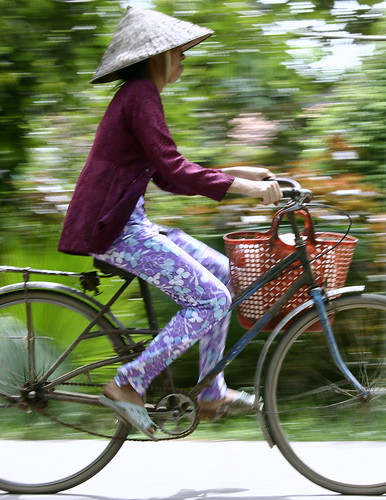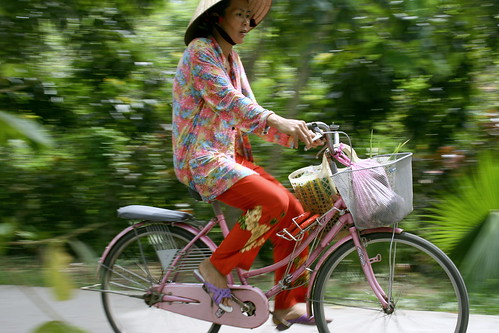panning Vietnam
Panning and I are not a good mix, at least at the start. That technique of photographing a moving object along its path of motion, keeping it sharp and defined, while blurring out the background, appears to be daunting, but with enough practice and patience, it can be a flashy tool to convey dynamism.
I remember my early attempts. This was about three years ago. My subject was the iconic yellow taxi of Manhattan but I was just new with my Canon 350D Rebel XT camera and the technique simply eluded me. Needless to say, the results were mediocre. I did not even upload any of my photos in flickr.
And when I checked, the earliest panning picture I put up online was an attempt I made on a woman in a traditional kanga robe, swishing her way across the road just below the 2nd floor restaurant I was in. Intriguing but still not impressive.
Canon EOS 350D Digital, 1/50s, f/11, 51mm, ISO 100
at Kenyatta Road, Stonetown, Zanzibar, Tanzania, East Africa
It took me several more experiments when finally, last year, I felt I finally succeeded in this technique at Jembatan Merah, the historic red bridge in Surabaya. The road to good panning was not easy but the techniques can be learned.
Jembatan Merah, Surabaya, East Java, Indonesia
Canon EOS 350D Digital, 1/10s, f/5.6, 31mm, ISO 800
Let me share some tips I have learned over time, specifically on the technique of divergent panning where the subject is kept at the same position of the frame all throughout the movement. (I will discuss other panning styles like zoomburst in other posts.)
For illustration, I am posting several pictures I took in my trip to Saigon (Ho Chi Minh), Vietnam last week. My subjects of choice were the ubiquitous Vietnamese ladies on bicycles. To me, the women on bikes are most graceful, be they in their defining ao dai ensemble, or in colorful daily clothes. That they almost always wear the identifiable conical non la hats adds the touch of local color that serves as a placemarker of the location.
1. shutter speed
Panning can be readily accomplished in exposures that can be as slow as ½ s or as fast as 1/100s. The final speed really depends on the effect that you want. Slow speed like 1/10s tend to give more blur, even on the subject, making panning more challenging. Fast speeds like 1/125s would need more timing skills to create the motion lines. Personally, my choice would be 1/50s, which is my pulse tolerance, i.e., the speed that I can take photos handheld without visible camera shake.
2. body position
There are several styles of tracking the moving subject with your body. The most popular is to start straight-bodied and then swivel at the hips in the direction of the subject, ending up in a twisted position, either on the left or the right. Others prefer to start in a twist of, say, 90 degrees, then move with the subject and end up in a “center stance”. Regardless, what is required is to move the camera even after you click the shutter. It also is necessary to keep your horizontal movement as smooth as possible, always following through the moving subject.
3. focus
Prefocus your camera at a point where your subject will pass to ensure the picture is sharp. A centered focusing often works for me although I may opt sometimes to leave negative space in front of or behind the subject.
a woman vendor at Cai Be, Vietnam
f/10, 1/50s, 55mm, ISO 100, shutter priority (TV)
4. background and foreground
As the background would end up in streaks, avoid a background which have large shapes, like a lamp post. Others prefer a darker background but my personal preference is to have a uniform or a repeating pattern. Be careful of objects which could block your panning in the foreground too. In the sample below, I had to crop the picture to eliminate a roadside display of white cans which are too distracting.
a student in Long An, Vietnam. People often use masks for protection against pollution
f/13, 1/40s, 55mm, ISO 400, shutter priority (TV)
5. lighting
Light that is too bright could prevent you in achieving proper exposure at relatively slow speed of 1/20 to 1/50s. I especially like to shoot when sky is cloudy, or at dusk or early morning. ND filters might become necessary too.
6. shutter speed priority (“TV” setting)
Panning in full manual could be problematic in conditions where outdoor light could change during the exposure. A quick fix is to set your camera at shutter speed priority, or the “TV” setting.
Cai Be, Vietnam
f/11, 1/50s, 33mm, ISO 100, shutter priority (TV)
7. flash
Another technique which I occasionally try is use flash. The flash freezes the subject and the long shutter speed still allows blurring of the background. A second curtain flash could be useful too. You may need to check your camera manual on how to do this.
So pan and enjoy!






3 comments:
and , thanks for sharing your skills on panning , id learn a lot~
I appreciate your visit!
Thank you very much for the tips! I am also trying to learn how to pan shots. Your tips will be really helpful to me
Post a Comment